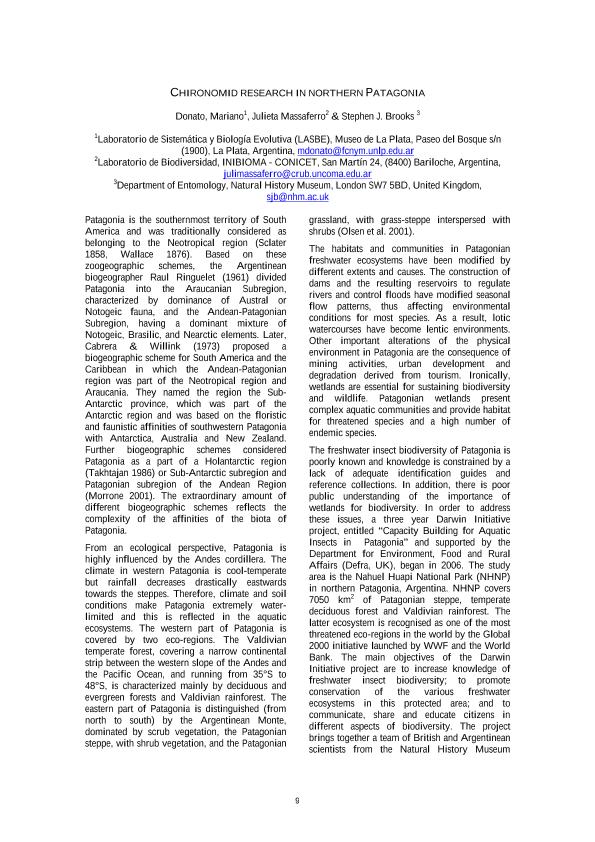Mostrar el registro sencillo del ítem
dc.contributor.author
Donato, Mariano Humberto

dc.contributor.author
Massaferro, Julieta

dc.contributor.author
Brooks, Stephen J.
dc.date.available
2018-04-18T17:24:59Z
dc.date.issued
2009-12
dc.identifier.citation
Donato, Mariano Humberto; Massaferro, Julieta; Brooks, Stephen J.; Chironomid Research in Northern Patagonia; Museum of Natural History and Archaeology, Norwegian University of Science and Technology; CHIRONOMUS Journal of Chironomidae Research; 22; 12-2009; 9-11
dc.identifier.issn
2387-5372
dc.identifier.uri
http://hdl.handle.net/11336/42493
dc.description.abstract
Patagonia is the southernmost territory of South America and was traditionally considered as belonging to the Neotropical region (Sclater 1858, Wallace 1876). Based on these zoogeographic schemes, the Argentinean biogeographer Raul Ringuelet (1961) divided Patagonia into the Araucanian Subregion, characterized by dominance of Austral or Notogeic fauna, and the Andean-Patagonian Subregion, having a dominant mixture of Notogeic, Brasilic, and Nearctic elements. Later, Cabrera & Willink (1973) proposed a biogeographic scheme for South America and the Caribbean in which the Andean-Patagonian region was part of the Neotropical region and Araucania. They named the region the SubAntarctic province, which was part of the Antarctic region and was based on the floristic and faunistic affinities of southwestern Patagonia with Antarctica, Australia and New Zealand. Further biogeographic schemes considered Patagonia as a part of a Holantarctic region (Takhtajan 1986) or Sub-Antarctic subregion and Patagonian subregion of the Andean Region (Morrone 2001). The extraordinary amount of different biogeographic schemes reflects the complexity of the affinities of the biota of Patagonia.
dc.format
application/pdf
dc.language.iso
eng
dc.publisher
Museum of Natural History and Archaeology, Norwegian University of Science and Technology
dc.rights
info:eu-repo/semantics/openAccess
dc.rights.uri
https://creativecommons.org/licenses/by-nc-sa/2.5/ar/
dc.subject
Chironomidae
dc.subject
Diversity
dc.subject
Patagonia
dc.subject.classification
Otras Ciencias Biológicas

dc.subject.classification
Ciencias Biológicas

dc.subject.classification
CIENCIAS NATURALES Y EXACTAS

dc.title
Chironomid Research in Northern Patagonia
dc.type
info:eu-repo/semantics/article
dc.type
info:ar-repo/semantics/artículo
dc.type
info:eu-repo/semantics/publishedVersion
dc.date.updated
2018-04-13T14:22:21Z
dc.journal.volume
22
dc.journal.pagination
9-11
dc.journal.pais
Noruega

dc.journal.ciudad
Trondheim
dc.description.fil
Fil: Donato, Mariano Humberto. Universidad Nacional de La Plata. Facultad de Ciencias Naturales y Museo. Laboratorio de Sistemática y Biología Evolutiva; Argentina
dc.description.fil
Fil: Massaferro, Julieta. Consejo Nacional de Investigaciones Científicas y Técnicas. Centro Científico Tecnológico Conicet - Patagonia Norte. Instituto de Investigaciones en Biodiversidad y Medioambiente. Universidad Nacional del Comahue. Centro Regional Universidad Bariloche. Instituto de Investigaciones en Biodiversidad y Medioambiente; Argentina
dc.description.fil
Fil: Brooks, Stephen J.. Natural History Museum; Reino Unido
dc.journal.title
CHIRONOMUS Journal of Chironomidae Research
dc.relation.alternativeid
info:eu-repo/semantics/altIdentifier/url/https://www.ntnu.no/ojs/index.php/chironomus/article/view/598
dc.relation.alternativeid
info:eu-repo/semantics/altIdentifier/doi/http://dx.doi.org/10.5324/cjcr.v0i22.598
Archivos asociados
